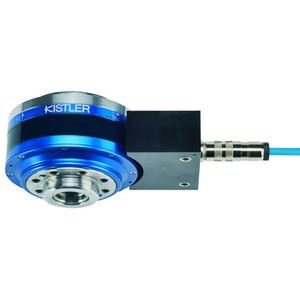The Dynamometer 9171A measures the cutting and torque forces even in the case of very heavy loads. This allows the processes of production machines to be analyzed and optimized while drawing conclusions on the wear of the tooling.
This fully redesigned piezoelectric dynamometer delivers a much higher range of rotational speeds, significantly improved dynamic properties and significant weight reduction.
This latest generation of dynamometer offers excellent measurement accuracy even with very heavy loads. Like all Kistler rotary devices and dynamometers, model 9171A also incorporates a piezoelectric sensor, capable of measuring forces and torques during the mechanical process with extreme precision due to its very high rigidity and high frequency.
This completely redesigned dynamometer has many improvements: a speed of rotation two and a half times faster, an improvement in dynamic properties and a decrease in its significant weight compared to previous models. The forces and torques can be measured with very heavy loads. The use of a new 4-component force sensor, which is totally rotationally symmetrical, minimizes the influence of centrifugal forces, and the more powerful electronics of the system delivers a signal of unparalleled quality.
With a wide range of forces up to 20 kN (Fx, Fy) or 30 kN (Fz) and a maximum torque of 1000 Nm, the 9171A is perfect for high-level industrial processes. A high performance cut is characterized by the removal of very large volumes of material in a very short time. This involves high forces and torques. The wide measuring range and compact design of the RCD 9171A allows it to fit perfectly with the HSK-A100 and Capto C8 pin interfaces used frequently in HPC. It is also possible, of course, to use smaller pin adapters.
Kistler's dynamometers are known for their robustness, compactness and ease of use. The 9171A is inserted on the machine shaft as a standard toolholder. Various adapters and tool holders are available from Kistler and can be supplied as required by the customer. This offers a great flexibility of interfaces for the user.
The measurement data is transferred and the current is supplied by a non-contact close-range telemetry system, which makes it possible to position the rotor and the stator further away from one another. Three different levels of low-pass filter can be installed, with immediate effect. Each force and torque can also be selected independently of each other, thus providing optimum signal control.
This fully redesigned piezoelectric dynamometer delivers a much higher range of rotational speeds, significantly improved dynamic properties and significant weight reduction.
This latest generation of dynamometer offers excellent measurement accuracy even with very heavy loads. Like all Kistler rotary devices and dynamometers, model 9171A also incorporates a piezoelectric sensor, capable of measuring forces and torques during the mechanical process with extreme precision due to its very high rigidity and high frequency.
This completely redesigned dynamometer has many improvements: a speed of rotation two and a half times faster, an improvement in dynamic properties and a decrease in its significant weight compared to previous models. The forces and torques can be measured with very heavy loads. The use of a new 4-component force sensor, which is totally rotationally symmetrical, minimizes the influence of centrifugal forces, and the more powerful electronics of the system delivers a signal of unparalleled quality.
With a wide range of forces up to 20 kN (Fx, Fy) or 30 kN (Fz) and a maximum torque of 1000 Nm, the 9171A is perfect for high-level industrial processes. A high performance cut is characterized by the removal of very large volumes of material in a very short time. This involves high forces and torques. The wide measuring range and compact design of the RCD 9171A allows it to fit perfectly with the HSK-A100 and Capto C8 pin interfaces used frequently in HPC. It is also possible, of course, to use smaller pin adapters.
Kistler's dynamometers are known for their robustness, compactness and ease of use. The 9171A is inserted on the machine shaft as a standard toolholder. Various adapters and tool holders are available from Kistler and can be supplied as required by the customer. This offers a great flexibility of interfaces for the user.
The measurement data is transferred and the current is supplied by a non-contact close-range telemetry system, which makes it possible to position the rotor and the stator further away from one another. Three different levels of low-pass filter can be installed, with immediate effect. Each force and torque can also be selected independently of each other, thus providing optimum signal control.
